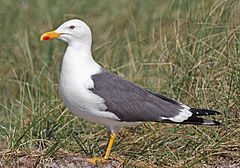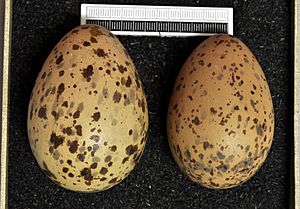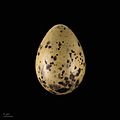Lesser black-backed gull facts for kids
Quick facts for kids Lesser black-backed gull |
|
|---|---|
 |
|
| Larus fuscus graellsii; England | |
| Conservation status | |
| Scientific classification | |
| Kingdom: | |
| Phylum: | |
| Class: | |
| Order: | |
| Family: | |
| Genus: |
Larus
|
| Binomial name | |
| Larus fuscus Linnaeus, 1758
|
|
The lesser black-backed gull (Larus fuscus) is a large gull that lives along the Atlantic coasts of Europe. These birds are migratory, meaning they travel long distances. They spend their winters from the British Isles all the way south to West Africa. Sometimes, they visit the east coast of North America during winter, likely coming from Iceland.
Contents
Appearance
The lesser black-backed gull looks a lot like the herring gull, but it's a bit smaller. It has a dark back and wings, which helps tell it apart from other gulls.
You can also tell it apart from the great black-backed gull because the lesser black-backed gull is smaller and has a thinner body. Its legs are yellow, not pinkish like the great black-backed gull's. It also has smaller white spots, called "mirrors," on its wing tips.
Its bill is yellow and has a bright red spot. When young gulls are hungry, they peck at this red spot. This action tells the adult gulls to feed them by regurgitation, which means they bring up food from their stomach for their babies. This is a natural, inherited behavior.
Reproduction
Lesser black-backed gulls often breed in large groups called colonies. They build their nests on the ground or on cliffs near coasts and lakes. They usually lay three eggs. In some cities, these gulls even nest in urban areas, sometimes alongside herring gulls.
Diet
Like most gulls, lesser black-backed gulls are omnivores. This means they eat both plants and animals. Their diet is quite varied and can include:
- Fish
- Insects
- Crabs and other crustaceans
- Worms
- Starfish
- Molluscs
- Seeds and berries
- Small mammals
- Eggs and small birds
- Scraps of food
- Offal (animal organs)
- Carrion (dead animals)
Gallery
Images for kids
-
L. f. intermedius in flight, Sweden
-
Gull hatching eggs in Pälkäne, Finland
-
L. f. graellsii adult, Morocco
-
L. f. graellsii young adult, Morocco
See also
 In Spanish: Gaviota sombría para niños
In Spanish: Gaviota sombría para niños















